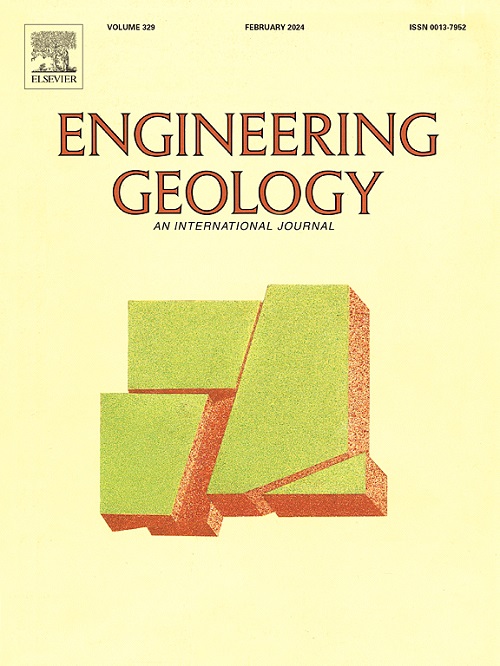里氏硬度测试作为评估接缝壁抗压强度(JCS)的工具
IF 8.4
1区 工程技术
Q1 ENGINEERING, GEOLOGICAL
引用次数: 0
摘要
岩石节理非线性抗剪强度的Barton-Bandis模型是岩石工程实践中最常用的强度准则。在确定接头粗糙度系数(JRC)方面已经取得了进展,例如使用激光扫描;然而,同样重要的节理壁抗压强度(JCS)参数并没有显著的进步。JRC和JCS在某种程度上是有效地联系在一起的。研究了一种灵敏的回弹硬度指数测试,即Leeb硬度(LH)测试,以提供一种可量化和可重复的JCS测定方法,相对于现有方法,该方法具有更高的准确性。提出了LH试验值(LD)与无侧限抗压强度(σc)的相关性,用于JCS测定。此外,本研究还研究了LH测试对具有分级硬度剖面的表面(例如风化表面)的影响区。这是通过使用一系列已知硬度的人造复合石膏-岩石样品来完成的,以深入了解由于对比硬度的底层材料对表面LD读数的影响。此外,采集了不同节理壁硬度的天然岩石试样,通过顺序面磨和测试获得了LD剖面。这些天然岩石标本包括那些相对于下面的完整岩石更软更硬的壁面材料。提出了硬度对比类型对硬度对比条件进行分类。研究结果表明,LH测试是预测JCS的合适工具,并提出了一种建议的方法。本文章由计算机程序翻译,如有差异,请以英文原文为准。
Leeb hardness test as a tool for joint wall compressive strength (JCS) evaluation
The Barton-Bandis model for the nonlinear shear strength of rock joints is the most commonly used strength criterion in rock engineering practice. There have been advancements in determination of Joint Roughness Coefficient (JRC), such as the use of laser scanning; however, the equally important Joint Wall Compressive Strength (JCS) parameter has not been significantly advanced. The JRC and JCS are effectively linked, to some extent. A sensitive rebound hardness index test, the Leeb Hardness (LH) test, was investigated to provide a quantifiable and repeatable method of JCS determination that offers increased accuracy relative to current methods. The LH test value () correlation to Unconfined Compressive Strength () is proposed for JCS determination. In addition, this study investigates the Influence Zone of the LH test on surfaces with graded hardness profiles (e.g., weathered surfaces). This was done using a series of artificial composite plaster-rock specimens of known hardness to provide insight into the influence effects on the surface reading due to underlying material of contrasting hardness. In addition, a collection of natural rock specimens with variable joint wall hardness were collected and profiles were obtained by sequential surface grinding and testing. These natural rock specimens included those with wall surface materials softer and harder relative to the underlying intact rock. A Hardness Contrast Type was proposed for classification of hardness contrast conditions. The study findings showed the LH test is a suitable tool for predicting JCS and a proposed methodology was presented.
求助全文
通过发布文献求助,成功后即可免费获取论文全文。
去求助
来源期刊

Engineering Geology
地学-地球科学综合
CiteScore
13.70
自引率
12.20%
发文量
327
审稿时长
5.6 months
期刊介绍:
Engineering Geology, an international interdisciplinary journal, serves as a bridge between earth sciences and engineering, focusing on geological and geotechnical engineering. It welcomes studies with relevance to engineering, environmental concerns, and safety, catering to engineering geologists with backgrounds in geology or civil/mining engineering. Topics include applied geomorphology, structural geology, geophysics, geochemistry, environmental geology, hydrogeology, land use planning, natural hazards, remote sensing, soil and rock mechanics, and applied geotechnical engineering. The journal provides a platform for research at the intersection of geology and engineering disciplines.
 求助内容:
求助内容: 应助结果提醒方式:
应助结果提醒方式:


